The Taj Express
When I first planned my travel route through India I was woefully ignorant. I tried to see too much too fast. I don’t regret what I have done, but were I to do it again I would spend twice as long and try to cover half as much ground. When I return, and return I shall, I will come for at least two months and concentrate on two or three states at the most. As it is I nearly missed the Taj Mahal.
It wasn’t until a couple of days before I headed to Delhi that I realized it would be silly to come all the way to India and not see the Taj Mahal. Luckily for me there is the Taj Express train which runs daily from Delhi to Agra (home of the Taj Mahal) and takes only about two and a half hours each way. On the train into Delhi I met a fellow American named John who had the same plan as I did so we got tickets and somehow managed to get up at 5:30 AM and catch the train.
But before I saw the Taj Mahal I visited the Agra Fort. I have seen about five forts in India now and I went to the Agra Fort more to pass the time than out of any real desire to see anything, but I was pleasantly surprised by the experience. 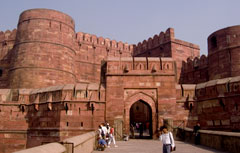 The Agra Fort is a massive red sandstone structure constructed by several rulers over a couple hundred years. It was originally built as an actual fort and then later a palace was added in. As is typical of India designs that were started by one ruler and finished by another, the fort has a sort of split personality. Half done in ornately carved red sandstone and half done in also ornately carved white marble, the blend is not so contrasting as you would think.
The Agra Fort is a massive red sandstone structure constructed by several rulers over a couple hundred years. It was originally built as an actual fort and then later a palace was added in. As is typical of India designs that were started by one ruler and finished by another, the fort has a sort of split personality. Half done in ornately carved red sandstone and half done in also ornately carved white marble, the blend is not so contrasting as you would think.
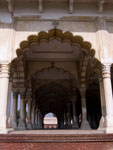 The sandstone is finely carved which I know I have said before, but the thing you have to realize is that sandstone crumbles and is probably the weakest stone out there, so to build with it, let alone carve anything out of it, is nothing sort of astonishing and to carve it with the kind of detail that the Indians have is extraordinary. It must be a very frustrating process, I imagine pieces must have frequently chipped or broken and had to be started all over again. Agra Fort was of a more Muslim design than those I saw in Rajasthan and owes this style of scalloped, arched colonnades to the influence of Persia. I was never able to find out for sure, but the Pearl Palace section seemed like it must have been designed by the same minds behind the Taj Mahal as it uses similar inlaid stones to create floral patterns in the marble.
The sandstone is finely carved which I know I have said before, but the thing you have to realize is that sandstone crumbles and is probably the weakest stone out there, so to build with it, let alone carve anything out of it, is nothing sort of astonishing and to carve it with the kind of detail that the Indians have is extraordinary. It must be a very frustrating process, I imagine pieces must have frequently chipped or broken and had to be started all over again. Agra Fort was of a more Muslim design than those I saw in Rajasthan and owes this style of scalloped, arched colonnades to the influence of Persia. I was never able to find out for sure, but the Pearl Palace section seemed like it must have been designed by the same minds behind the Taj Mahal as it uses similar inlaid stones to create floral patterns in the marble.
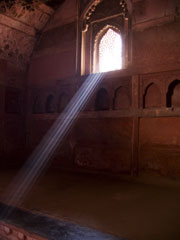 In one area of the fort right near the entrance to the main palace there was a very dark room with a single screened window that let through an extraordinary little beam of light like a spotlight of sun that slowly migrated across the floor as the morning went on until, by the time we left, it was gone entirely.
In one area of the fort right near the entrance to the main palace there was a very dark room with a single screened window that let through an extraordinary little beam of light like a spotlight of sun that slowly migrated across the floor as the morning went on until, by the time we left, it was gone entirely.
After a few hours in the Fort, my traveling companion and I walked through a rather large park separating the Fort from the Taj Mahal. Like Prospect Park in Brooklyn this park leaned to the wild rather than cultivated side, though there were some areas with fountains and the like. Unfortunately the smog in Agra is very bad and most of the trees had a brownish cast and thick coating of diesel dust on their leaves. Since he was leaving Delhi by plane the next morning, John wanted to do a little shopping while I opted to just head straight into the Taj Mahal complex. After paying the exorbitant 750 rupee entrance fee, you walk past a few red sandstone structures and hang a left toward the massive red sandstone entry gate which is inscribed with verses from the Koran.
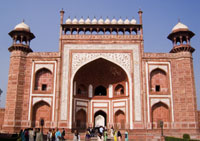 The room you pass through is rather dark and it was difficult to see much detail on the inside, but I think the point of the darkness was really to emphasis what the entry arch opens up into. As I have mentioned previously the Taj Mahal is one of the Seven Wonders of the World, along with the great wall in China, the pyramids in Egypt etc. Given this level of hype I was fully prepared to be underwhelmed, but in fact I find it difficult to describe what it’s like to pass out of the gate and into the Taj Garden area, there are probably at least dozen synonyms of beautiful that I could toss out, but none would begin to cover the experience. I have never in my life seen anything so extravagant, elegant and colossal. It took twenty-two years to build, but standing in front of the garden waterways staring out at the sheer mass of marble that must of flattened at least one mountain, possibly more for its creation, twenty-two years sounds unbelievably fast.
The room you pass through is rather dark and it was difficult to see much detail on the inside, but I think the point of the darkness was really to emphasis what the entry arch opens up into. As I have mentioned previously the Taj Mahal is one of the Seven Wonders of the World, along with the great wall in China, the pyramids in Egypt etc. Given this level of hype I was fully prepared to be underwhelmed, but in fact I find it difficult to describe what it’s like to pass out of the gate and into the Taj Garden area, there are probably at least dozen synonyms of beautiful that I could toss out, but none would begin to cover the experience. I have never in my life seen anything so extravagant, elegant and colossal. It took twenty-two years to build, but standing in front of the garden waterways staring out at the sheer mass of marble that must of flattened at least one mountain, possibly more for its creation, twenty-two years sounds unbelievably fast.
The main building, the famous one you see in pictures, is the single most massive structure of marble I’ve ever seen. It sits on a raised platform about twenty meters high and then towers over everything in the surrounding area by at least two hundred meters. The main building is flanked on either side by a pair of mosques, only one of which is actually a mosque, the other, because it faces the wrong way, is purely for symmetry. And symmetry is the theme of the Taj Mahal; the main mausoleum building is perfectly symmetrical and looks exactly the same on all four sides. In each corner, set about one hundred meters from the building are four minarets made of the same semi-translucent white marble that makes up the rest of the mausoleum. The marble is covered in inlaid stone and semi precious minerals some or which are floral patterns and some of which form verses of the Koran. The vaulted archways of the main building have some of the most complicated curves and vaulting you can possibly imagine and yet are made of massive blocks of marble, a marvel of engineering that probably couldn’t be repeated today without laser saws. And let me point out that when I say massive and colossal I don’t necessarily mean just big, it is big, but not that big, it is, well it’s so solid, so unbroken by windows or anything else save archways which really just make it seem even more solid. It’s very difficult to capture with words.
 I spent about three hours wandering around the garden sitting down on different benches and just staring at the Taj Mahal. It’s quite literally indescribable. I finally sat down on one bench on the west side of the garden and tried to let the place sink in a little bit but it just wouldn’t do it. It is too big, too massive, too marble, too beautiful to swallow. Where the Louvre would take two lifetimes to see every work of art, the Taj Mahal would take two lifetimes simply for its existence to become real to me. The grounds were crowded with tourists, Indian and Foreign alike, but not so crowded as the guidebooks make it sound, they milled about pointing cameras at the Taj often with friends or lovers in the foreground as if just the building itself would be too much, that it needed some sort of human reference point beside it to make any sense.
I spent about three hours wandering around the garden sitting down on different benches and just staring at the Taj Mahal. It’s quite literally indescribable. I finally sat down on one bench on the west side of the garden and tried to let the place sink in a little bit but it just wouldn’t do it. It is too big, too massive, too marble, too beautiful to swallow. Where the Louvre would take two lifetimes to see every work of art, the Taj Mahal would take two lifetimes simply for its existence to become real to me. The grounds were crowded with tourists, Indian and Foreign alike, but not so crowded as the guidebooks make it sound, they milled about pointing cameras at the Taj often with friends or lovers in the foreground as if just the building itself would be too much, that it needed some sort of human reference point beside it to make any sense.
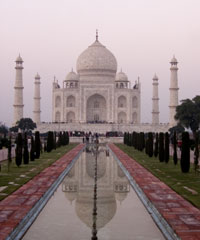 Perhaps what makes the Taj Mahal so magnificent is that it provokes no singular association, no context, no memory that can be associated with it, but rather seems to call on all your references, all your memories and all your past associations at once so that your brain is overwhelmed and goes completely blank leaving you with the sensation that it might be a threat to your very existence, that the Taj were capable of wiping you to a blank slate and then writing or not writing whatever it might choose, so that the feeling you are left with is that the Taj Mahal seems mythically, spiritually, as well as architecturally, to have risen from nowhere, without equal or context.
Perhaps what makes the Taj Mahal so magnificent is that it provokes no singular association, no context, no memory that can be associated with it, but rather seems to call on all your references, all your memories and all your past associations at once so that your brain is overwhelmed and goes completely blank leaving you with the sensation that it might be a threat to your very existence, that the Taj were capable of wiping you to a blank slate and then writing or not writing whatever it might choose, so that the feeling you are left with is that the Taj Mahal seems mythically, spiritually, as well as architecturally, to have risen from nowhere, without equal or context.
And that is the only stab I will make at describing what is a singular experience, and I will not even begin to tell you what is on the inside in the hope that perhaps one day you will make the journey to see it for yourself.
Thoughts?
Please leave a reply:
All comments are moderated, so you won’t see it right away. And please remember Kurt Vonnegut's rule: “god damn it, you’ve got to be kind.” You can use Markdown or HTML to format your comments. The allowed tags are
<b>, <i>, <em>, <strong>, <a>. To create a new paragraph hit return twice.